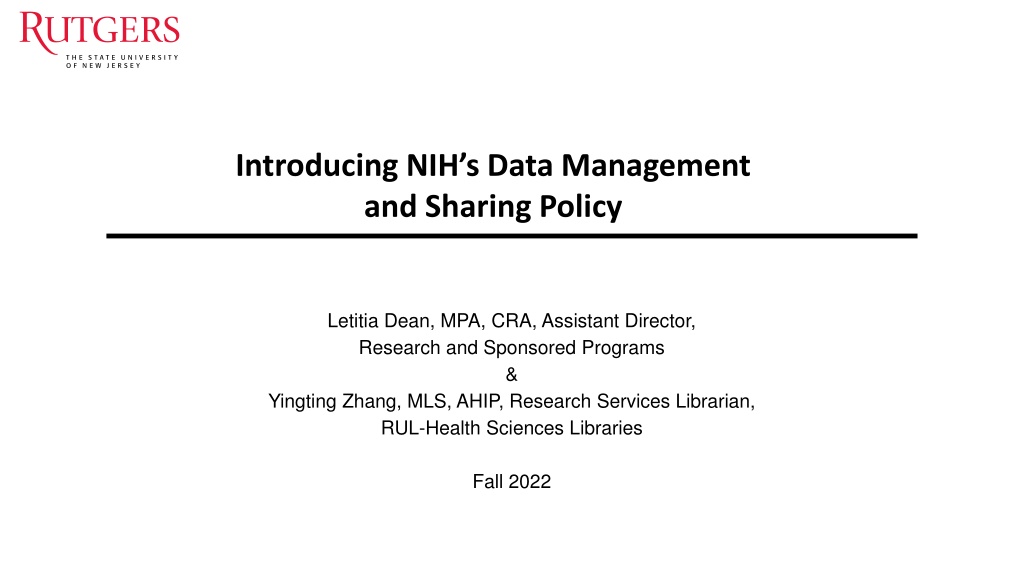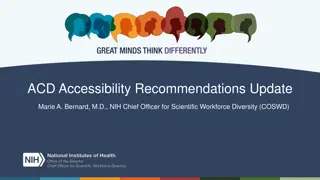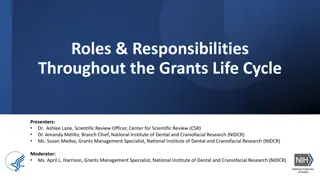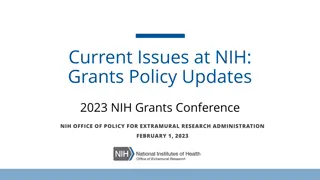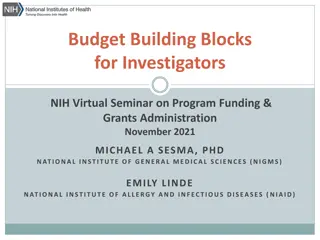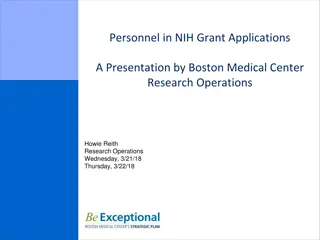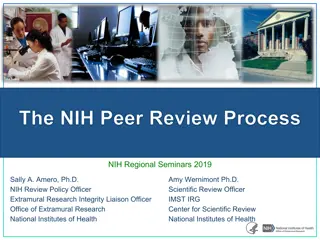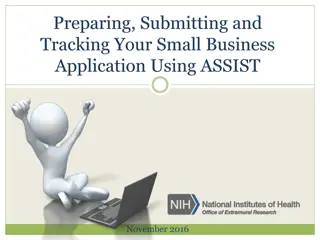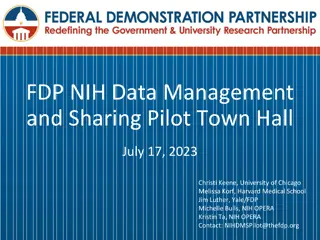Introducing NIH’s Data Management
The NIH Data Management and Sharing Policy outlines the evolution of data sharing initiatives at NIH, from the inception of the Data Sharing Policy in 2003 to the latest Data Management and Sharing Policy effective January 25, 2023. The policy emphasizes the importance of data sharing in enhancing scientific research and maximizing the impact of NIH-funded projects. It covers allowable costs, elements of the policy, selection of data repositories, and the use of tools like DMPTool to create data management plans. The policy applies to all NIH-funded or conducted research projects that generate scientific data, aiming to promote transparency, accessibility, and collaboration in the research community.
Download Presentation

Please find below an Image/Link to download the presentation.
The content on the website is provided AS IS for your information and personal use only. It may not be sold, licensed, or shared on other websites without obtaining consent from the author.If you encounter any issues during the download, it is possible that the publisher has removed the file from their server.
You are allowed to download the files provided on this website for personal or commercial use, subject to the condition that they are used lawfully. All files are the property of their respective owners.
The content on the website is provided AS IS for your information and personal use only. It may not be sold, licensed, or shared on other websites without obtaining consent from the author.
E N D
Presentation Transcript
Introducing NIHs Data Management and Sharing Policy Letitia Dean, MPA, CRA, Assistant Director, Research and Sponsored Programs & Yingting Zhang, MLS, AHIP, Research Services Librarian, RUL-Health Sciences Libraries Fall 2022
Outline Background of NIH Data Sharing NIH Data Management and Sharing Policy (DMSP) Allowable Costs Elements of NIH DMSP and Selection of Data Repositories Using DMPTool to Create NIH DMS Plans Demo of DMPTool Q & A 2
Background of NIH Data Sharing 2003 NIH Data Sharing Policy 2007 NIH Genome-Wide Association Studies (GWAS) Policy 2008 NIH Public Access Policy 2014 NIH Genomic Data Sharing Policy (effective Jan 25, 2015) 2015 NIH first intent to encourage broad data sharing (for increasing access to scientific publications and digital scientific data from NIH funded scientific research 2016 NIH Clinical Trials Policy (Policy on the Dissemination of NIH-Funded Clinical Trial Information, requiring NIH-funded or conducted clinical trials be registered and have summary results information submitted to ClinicalTrials.gov. 2018 NIH Request for Information on Proposed Provisions of a Draft Data Management and Sharing Policy for NIH Funded or Supported Research. 2019 NIH released the DRAFT NIH Policy for Data Management and Sharing for public input. 2020 NIH announced the Final NIH Policy for Data Management and Sharing Source - https://grants.nih.gov/grants/guide/notice-files/NOT-OD-21-013.html 3
NIH Data Sharing Policy (DSP) & Data Management Sharing Policy (DMSP) The current NIH Data Sharing policy, in effect since 2003, remains in effect until January 24, 2023 The new NIH Policy on Data Management and Sharing (effective January 25, 2023) Sharing.nih.gov https://sharing.nih.gov/about/learning 4
Data Management and Sharing Policy (DMSP) effective January 25, 2023 Effective January 25, 2023, the NIH Data Management and Sharing (DMS) Policy applies to all research that meets these criteria regardless of funding level: Is funded or conducted in whole or in part by NIH Results in the generation of scientific data The DMS Policy does not apply to research and other activities that do not generate scientific data. Examples include: Training (Ts), Fellowships (Fs), Certain non-research Career Awards (e.g. KM1), Construction (C06), Conference Grants (R13), Resources (Gs), Research-related Infrastructure programs (e.g., S06) and non-research activities. 5
Scientific Data Scientific Data is defined as data commonly accepted in the scientific community as of sufficient quality to validate and replicate research findings, regardless of whether the data are used to support scholarly publications. Scientific data includes any data needed to validate and replicate research findings. Scientific data does not include laboratory notebooks, preliminary analyses, completed case report forms, drafts of scientific papers, plans for future research, peer reviews, communications with colleagues, or physical objects such as laboratory specimens." 6
Data Management and Sharing Policy (DMSP) Requirements Applicants will be required to submit a two-page data management and sharing plan and to comply with that plan. 1. Submission of an official Data Management and Sharing (DMS) Plan as part of all applications for funding beginning January 25, 2023. 2. Compliance with the DMS Plan approved by the funding NIH Institute, Center, or Office. The approved plan becomes a part of the terms and conditions of the grant. Compliance will be monitored at regular reporting intervals by the funding NIH Institute, Center or Office and may factor into future funding decisions. 7
Allowable Costs for Data Management and Sharing Curating data and developing supporting documentation Local data management considerations Preserving and sharing data through established repositories Policy allows investigators to request funding for personnel costs or other fees related to data management and sharing activities; however, the money must be spent during the grant s award period. Source: NOT-OD-21-015: Supplemental Information to the NIH Policy for Data Management and Sharing: Allowable Costs for Data Management and Sharing 8
Submitting DMS Budgets Direct costs to support the activities proposed in the DMS Plan must be indicated as Data Management and Sharing Costs R&R Budget Form: line item in section F. Other Direct Costs Data Management and Sharing Costs PHS 398 Modular Budget Form: within Additional Narrative Justification 9 (source: NIH)
Data Management and Sharing Policy (DMSP) Additional Details The policy does not require researchers to share data per se but expects them to maximize their data sharing. NIH strongly encourages the use of established repositories to the extent possible for preserving and sharing scientific data. Grant reviewers will see the data management plan and can comment on the budget, but plans are not used to determine the grant s scientific merit. An optional Data Management and Sharing Plan format page will be provided to assist applicants with the preparations of this attachment. A fillable version will be available by Fall 2022 and instructions will be incorporated into the NIH Application Form Instructions (New Forms H). Use of this format page or other approaches (e.g. DMPTool) will be accepted. DMS Plan is uploaded to application in the Research Plan Section (#11. Other Plans). 10
Format of a DMS Plan Plans should be no more than 2 pages in length Optional format page will be available DMS Plan format page will be added to list of Format Pages and incorporated into FORMS-H application instructions by Fall 2022 11 (source: NIH)
DMS Plan Submission A new Other Plan(s) field will be added to the PHS 398 form to collect a single PDF attachment Data Sharing Plans and Genomic Data Sharing Plans will no longer be submitted to the Resource Sharing Plan(s) field 12 (source: NIH)
Data Management and Sharing Policy (DMSP) Limitations on Sharing DMS Plans should maximize appropriate sharing Justifiable ethical, legal, and technical factors for limiting sharing include: Informed consent will not permit or limits the scope of sharing or use Privacy or safety of research participants would be compromised and available protections are insufficient Explicit federal, state, local, or Tribal law, regulation, or policy prohibits disclosure Restrictions are imposed by existing or anticipated agreements with other parties Reasons NOT generally justifiable to limit sharing: Data are considered too small Researchers anticipate data will not be widely used Data are thought not to have a suitable repository 13
Protecting Privacy When Sharing Human Participant Data NIH Released the Following Supplemental Information regarding Human Participant Data: Provides list of principles and considerations researchers should uphold in their plans and throughout their research project. NOT-OD-22-213 Supplemental Information to the NIH Policy for Data Management and Sharing: Protecting Privacy When Sharing Human Research Participant Data NOT-OD-22-214 Supplemental Information to the NIH Policy for Data Management and Sharing: Responsible Management and Sharing of American Indian/Alaska Native Participant Data 14
Data Management and Sharing Policy (DMSP) Monitoring Compliance NIH will monitor compliance with Plans over the course of the funding period during regular reporting intervals (e.g., at the time of annual Research Performance Progress Reports (RPPRs)). Steps include: Submit plan as part of the application At Just-in-Time (JIT) clarification or updates may be requested Approved DMS Plan becomes a Term and Condition of the Award Grantee reports progress of approved DMS Plan in RPPR NIH reviews compliance annually Failure to comply with DMS Plans may result in the NIH adding special Terms and Conditions of Award or terminating the award. If award recipients are not compliant with Plans at the end of the award, noncompliance may be factored into future funding decisions. For contracts, noncompliance with the DMS Plan will be handled in accordance with the terms and conditions of the contract and applicable Federal Acquisition Regulation (FAR). 15
Elements of an NIH DMS Plan Related Tools, Software and/or Code Standards Data Type Data Preservation, Access, and Associated Timelines Access, Distribution, or Reuse Considerations Oversight of Data Management and Sharing 16 Source: https://grants.nih.gov/grants/guide/notice-files/NOT-OD-21-014.html
1. Data Type Briefly describe the type and amount of data to be managed and shared. A.Types and amount of scientific data expected to be generated in the project NIH Example Answer This project will produce _________ [Data type, e.g., imaging, sequencing, experimental measurements] data generated/obtained from __________ [e.g., instrument, method, survey, experiment, data repository]. Data will be collected from ___ [number] of research participants/specimens/experiments, generating ___ [number] datasets totaling approximately ___ [amount of data] in size. The following data files will be used or produced in the course of the project: ______ [list input data files, intermediate files, and final, post-processed files]. Raw data will be transformed by ____ [analysis, method] and the subsequent processed dataset used for statistical analysis. To protect research participant identities, ___________ [e.g., individual, aggregated, summarized] data will be made available for sharing. Source: DMPTool - based on the "NIH-GEN DMSP (Forthcoming 2023) " template provided by NIH (nih.gov) - (ver: 4, pub: 2022-10-06) | & https://sharing.nih.gov/data-management-and- sharing-policy/planning-and-budgeting-DMS/writing-a-data-management-and-sharing-plan#after) 17
1. Data Type (Contd) B. Describe which scientific data will be preserved and shared, and the reasoning for the decisions NIH example answer Based on _______ [ethical, legal, technical] considerations, the following data produced in the course of the project will be preserved and shared: ____ [list] OR All data produced in the course of the project will be preserved and shared. C. List the metadata, other relevant data, and associated documentation to be used to facilitate interpretation of the scientific data NIH example answer To facilitate interpretation of the data, ______ [e.g., metadata, documentation, protocols, data collection instruments] will be shared and associated with the relevant datasets. 18 Source: DMPTool & https://sharing.nih.gov/data-management-and-sharing-policy/planning-and-budgeting-DMS/writing-a-data-management-and-sharing-plan#after
2. Related Tools, Software and/or Code Indicate whether specialized tools, software, and/or code are needed to access or manipulate shared scientific data, and if so, provide the name(s) of the needed tool(s) and software and specify how they can be accessed. NIH example answer If no specialized tools are needed to access or manipulate the data: _____ [Data type - Imaging data, survey data, etc] data will be made available in _____ [csv, txt, etc] format and will not require the use of specialized tools to be accessed or manipulated. If specialized tools are needed to access or manipulate the data: _____ [Data type] data will be made available in _____ format, which requires the use of specialized tools, such as _____ [include list of tools] to be accessed and manipulated. 19 Source: DMPTool & https://sharing.nih.gov/data-management-and-sharing-policy/planning-and-budgeting-DMS/writing-a-data-management-and-sharing-plan#after
2. Related Tools, Software and/or Code (Contd) If applicable, specify how needed tools can be accessed, (e.g., open source and freely available, generally available for a fee in the marketplace, available only from the research team) and, if known, whether such tools are likely to remain available for as long as the scientific data remain available. NIH example answer The ____ tool, which can be used to ____ is available free of charge through ____ [source name] The ____ tool, which can be used to ____ is available for a fee of ____ through ____ [source name]. Custom tools to ____ will be/have been developed by the research team. Requests for these tools should be directed to ____ [include details of members of the research team]. These tools will be shared openly via ____. (source: DMPTool) 20
3. Standards Describe what common data standards, if any, will be applied to the scientific data and associated metadata (i.e., data formats, data dictionaries, data identifiers, definitions, unique identifiers, and other data documentation) to enable interoperability of datasets. NIH Example Answer To facilitate their efficient use, all of our data and materials will be structured and described using the following standards: If there are formal data standards for some/all of the data: Whenever possible, we will use ______ [common data elements, standardized survey instruments, etc] to structure and organize our data. Our ____ data will be structured and described using the ____ standard, which has been widely adopted in the ____ community. [Add additional information about this standard, if applicable - e.g. implementation in data repositories, utility in combining/reusing datasets] If there are not formal standards: Formal standards for ____ data have not yet been widely adopted. However, our data and other materials will be structured and described according to best practices. Data will be stored in common and open formats, such as ____ for our ____ data. Information needed to make use of this data [e.g. the meaning of variable names, codes, information about missing data, other metadata etc] will be recorded in ____ [data dictionaries/codebooks] that will be accessible to the research team and will subsequently be shared alongside final datasets. Information about our research process, including the details of our analysis pipeline will be maintained contemporaneously, using ____ [lab notebooks, protocols, etc]. This information will be accessible to all members of the research team and will be shared alongside our data. 21 Source: DMPTool & https://sharing.nih.gov/data-management-and-sharing-policy/planning-and-budgeting-DMS/writing-a-data-management-and-sharing-plan#after
4. Data Preservation, Access, and Associated Timelines Provide the name of the repository(ies) where scientific data and metadata arising from the project will be archived. Select a Data Repository where scientific data and metadata will be archived. NIH Example Answer All dataset(s) that can be shared will be deposited in _________ [Add appropriate NIH-supported data repositories] OR ________ [Add appropriate subject or disease repositories] 22 Source: DMPTool & https://sharing.nih.gov/data-management-and-sharing-policy/planning-and-budgeting-DMS/writing-a-data-management-and-sharing-plan#after
4. Data Preservation, Access, and Associated Timelines (Contd) Describe how the scientific data will be findable and identifiable, i.e., via a persistent unique identifier or other standard indexing tools. NIH example answer The _________ [Insert repository name] provides metadata, persistent identifiers [i.e., insert whether DOI, handles, other], and long-term access. This repository is supported by ________[Insert funder/organization] and dataset(s) are available under a _______ [Insert license information] OR through a request process __________ [Insert information about request process]. 23 Source: DMPTool & https://sharing.nih.gov/data-management-and-sharing-policy/planning-and-budgeting-DMS/writing-a-data-management-and-sharing-plan#after
4. Data Preservation, Access, and Associated Timelines (Contd) Describe when the scientific data will be made available to other users (i.e., no later than time of an associated publication or end of the performance period, whichever comes first) and for how long data will be made available. NIH Example Answer Data will be made available as soon as possible or at the time of associated publication. 24 (source: DMPTool) Source: DMPTool & https://sharing.nih.gov/data-management-and-sharing-policy/planning-and-budgeting-DMS/writing-a-data-management-and-sharing-plan#after
5. Access, Distribution, or Reuse Considerations Researchers are expected to maximize the appropriate sharing of scientific data generated from NIH-funded or conducted research, consistent with privacy, security, informed consent, and proprietary issues. NIH Example Answer For researchers working with human subjects data In order to ensure participant consent for data sharing, IRB paperwork and informed consent documents will include language describing plans for data management and sharing data, describing the motivation for sharing, and explaining that personal identifying information will be removed. To protect participant privacy and confidentiality, shared data will be de-identified using the ______ method. [Describe de-identification method, noting any other applicable laws or policies such as HIPAA]. For researchers selecting controlled access repositories Given the sensitive nature of the dataset, de-identified human subjects data will be made available in ________ data repository, which restricts access to the data to qualified investigators with an appropriate research question who sign a data use agreement. [Describe data repository access methods and security measures]. 25 Source: DMPTool & https://sharing.nih.gov/data-management-and-sharing-policy/planning-and-budgeting-DMS/writing-a-data-management-and-sharing-plan#after
6. Oversight of Data Management and Sharing NIH example Answer The following individuals [or just the position titles if unknown] will be responsible for data collection, management, storage, retention, and dissemination of project data, including updating and revising the Data Management and Sharing Plan when necessary. Name, Position Title, Host Institution, ORCID, email 26 (source: DMPTool) Source: DMPTool & https://sharing.nih.gov/data-management-and-sharing-policy/planning-and-budgeting-DMS/writing-a-data-management-and-sharing-plan#after
Select a Data Repository Except some initiatives and funding opportunities that have individual requirements, NIH does not specify a particular repository for sharing data. NIH encourages researchers to select the repository that is most appropriate for their data type and discipline NIH strongly encourages the use of established quality repositories for preserving and sharing scientific data to achieving the FAIRness of the data. NIH-Supported Scientific Data Repositories - https://sharing.nih.gov/data-management-and-sharing- policy/sharing-scientific-data/repositories-for-sharing-scientific-data NIH Supported Open Domain Specific Data Repositories that make data accessible for reuse and are open for both submitting and accessing data - https://www.nlm.nih.gov/NIHbmic/domain_specific_repositories.html If no suitable repository was found in the above repositories, consider the following: A listing of generalist repositories that accepts all data types Nature s Data Repository Guidance The Registry of Research Data Repositories (re3data.org) 27
Generalist Data Repositories Dataverse The Harvard Dataverse Repository is an open source web application to share, preserve, cite, explore, and analyze research data. Researchers also have full control of their datasets. Dryad Dryad is a non-profit membership organization. It is general and can be used for a wide diversity of data types Figshare - Researchers can deposit their research outputs in Figshare and make them available, citable, shareable and discoverable. All researchers with NIH funding are invited to use Figshare to make all the products of their research publicly available, reusable, and citable when a discipline-specific repository is unavailable. Figshare.com is free for researchers. 28 Generalist Repositories | Data Sharing (nih.gov)
Generalist Data Repositories (Contd) Mendeley Data - owned by Elsevier. DataCite DOI is assigned to datasets. Open Science Framework - OSF is a free, open platform to support your research and enable collaboration. How to share data in OSF - Sharing data - OSF Support (https://help.osf.io/article/218-sharing-data) Synapse - The knowledge portals are community-specific interfaces that enable researchers to explore and share data, analyses, and tools, by Sage Bionetworks which is a nonprofit health research organization. Vivli - Vivli is an independent, non-profit organization that has developed a global data-sharing and analytics platform. Zenodon - The name Zenodo is derived from Zenodotus, the first librarian of the Ancient Library of Alexandria and father of the first recorded use of metadata, a landmark in library history. 29 Generalist Repositories | Data Sharing (nih.gov)
Desirable Characteristics for All Data Repositories Unique Persistent Identifiers Long-Term Sustainability Metadata Curation and Quality Assurance Free and Easy Access Broad and Measured Reuse Clear Use Guidance Security and Integrity Confidentiality Common Format Provenance Retention Policy Source: NOT-OD-21-016: Supplemental Information to the NIH Policy for Data Management and Sharing: Selecting a Repository for Data Resulting from NIH-Supported Research 30
Additional Considerations for Repositories Storing Human Data (even if de-identified) Fidelity to Consent Restricted Use Compliant Privacy Plan for Breach Download Control Violations Request Review September 21, 2022 - NIH Releases Supplemental Information on the NIH Policy for Data Management and Sharing : Supplemental Information to the NIH Policy for Data Management and Sharing: Protecting Privacy When Sharing Human Research Participant Data Supplemental Information to the NIH Policy for Data Management and Sharing: Responsible Management and Sharing of American Indian/Alaska Native Participant Data 31 Source: NOT-OD-21-016: Supplemental Information to the NIH Policy for Data Management and Sharing: Selecting a Repository for Data Resulting from NIH-Supported Research
Useful Links NIH Data Sharing Policy website - NIH Data Sharing Information - Main Page. Final NIH Policy for Data Management and Sharing - https://grants.nih.gov/grants/guide/notice-files/NOT-OD- 21-013.html Supplemental Information to the NIH Policy for Data Management and Sharing: Elements of an NIH Data Management and Sharing Plan - https://grants.nih.gov/grants/guide/notice-files/NOT-OD-21-014.html Supplemental Information to the NIH Policy for Data Management and Sharing: Allowable Costs for Data Management and Sharing - https://grants.nih.gov/grants/guide/notice-files/NOT-OD-21-015.html Supplemental Information to the NIH Policy for Data Management and Sharing: Selecting a Repository for Data Resulting from NIH-Supported Research - https://grants.nih.gov/grants/guide/notice-files/NOT-OD-21- 016.html NIH Scientific Data Sharing - https://sharing.nih.gov/data-management-and-sharing-policy (Planning and Budgeting for Data Management & Sharing) | Data Management | Sharing Scientific Data) Planning and Budgeting for Data Management & Sharing - https://sharing.nih.gov/data-management-and- sharing-policy/planning-and-budgeting-for-data-management-and-sharing (Write a DMSP | Budgeting for DMS) Data Management - https://sharing.nih.gov/data-management-and-sharing-policy/data-management Sharing Scientific Data - https://sharing.nih.gov/data-management-and-sharing-policy/sharing-scientific-data 32
DMPTool Developed by the University of California Curation Center of the California Digital Library Free and accessible at https://dmptool.org/ Rutgers is an institutional member. Supports major funders (e.g. NIH, NSF, etc.) and updated when funders release new requirements Offers templates to create a DMSP for NIH grants Uses step-by-step wizard to create a plan. Possible to co-create/edit plans 33
DMPTool - https://dmptool.org/ https://dmptool.org/ 34
Research Data Services at RUL https://www.libraries.rutgers.edu/research-tools-and-services/research-data-services 36
Demo of DMPTool Thank You! Questions on NIH DMSP? Contact: deanle@research.rutgers.edu yzhang@libraries.rutgers.edu 37
